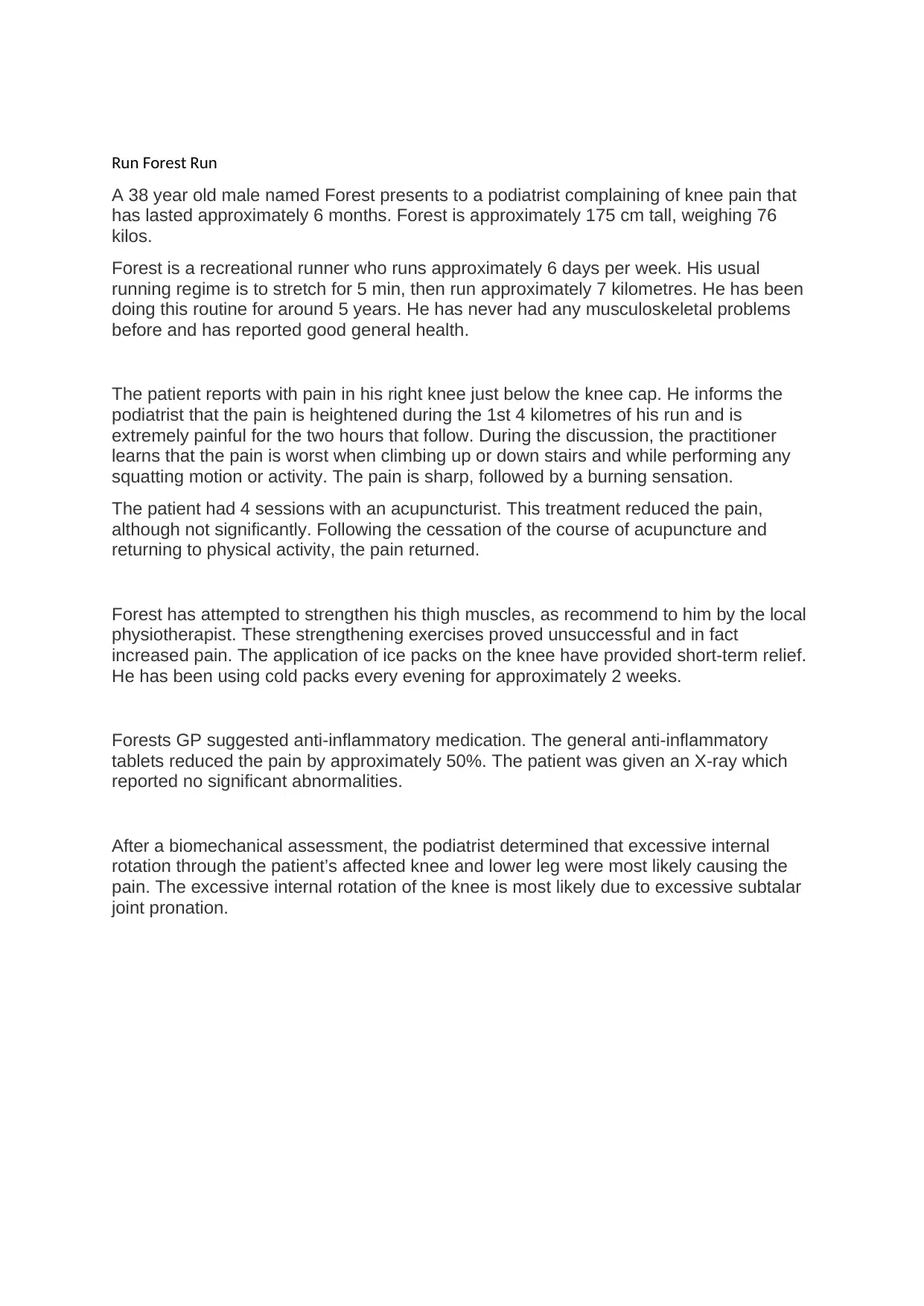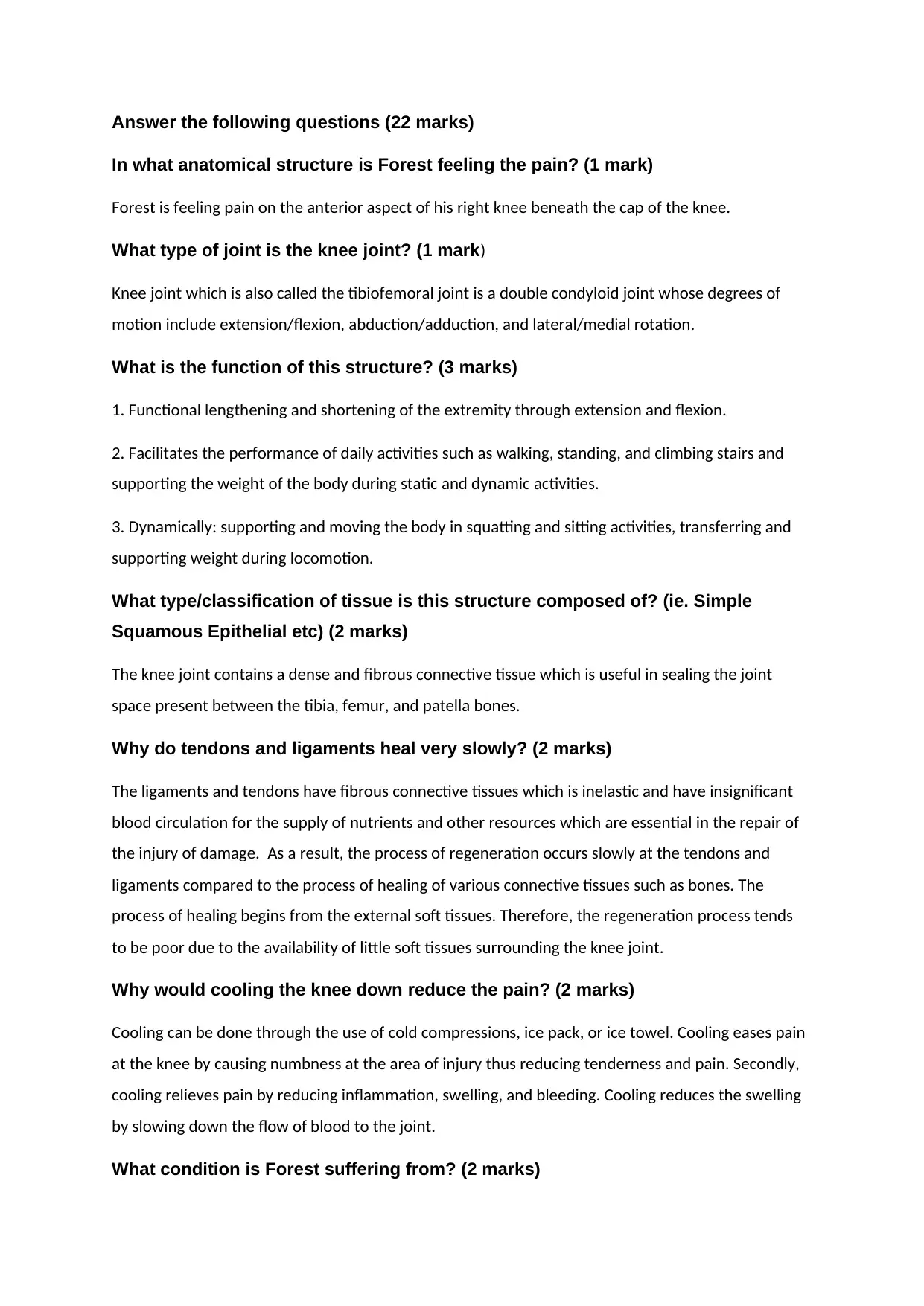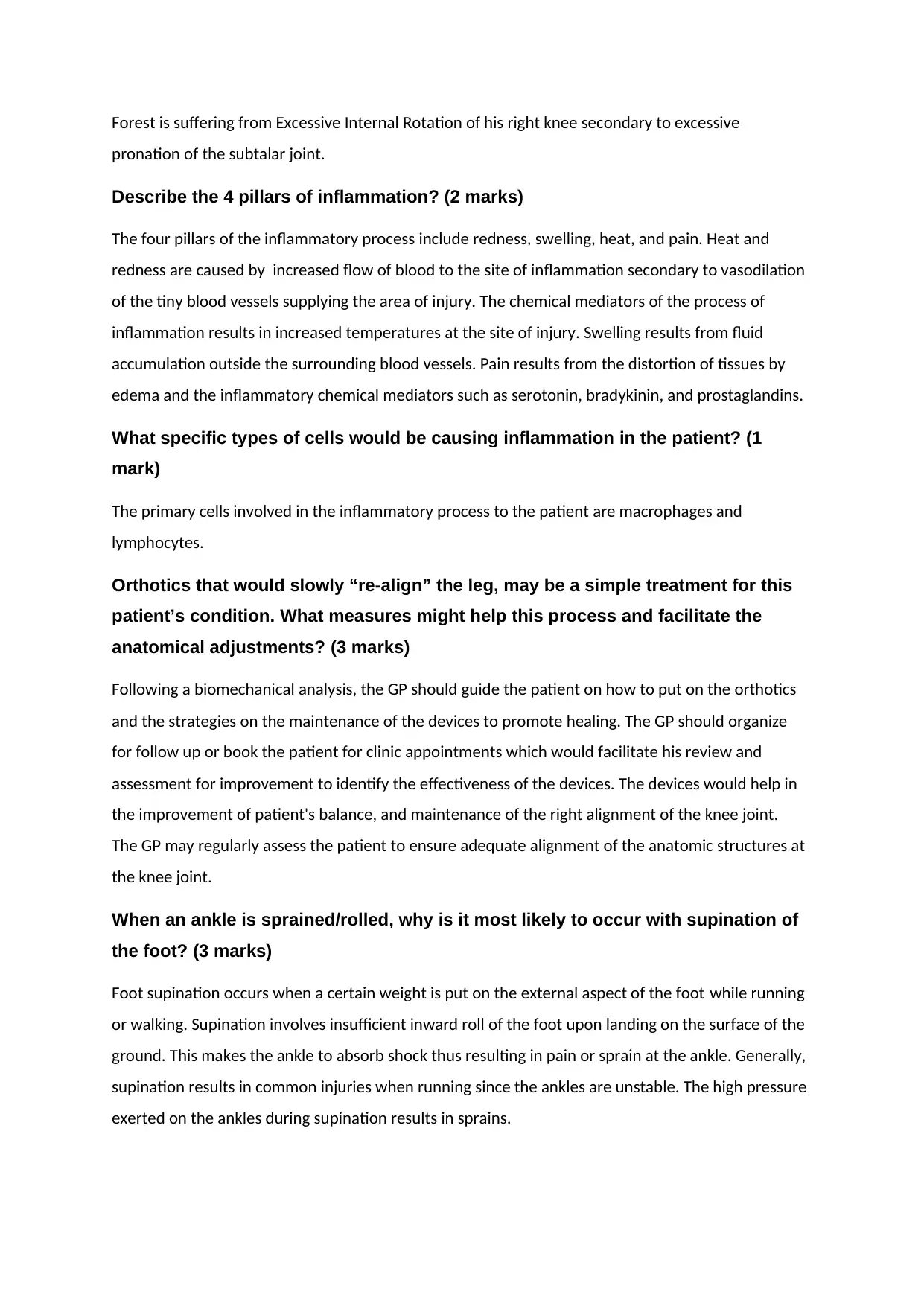Analysis of Podiatry Case: Run Forest Run, Knee Pain, Biomechanics
VerifiedAdded on 2023/01/06
|4
|1167
|57
Homework Assignment
AI Summary
This assignment analyzes a podiatry case study involving a 38-year-old male, Forest, experiencing knee pain. The analysis begins with identifying the anatomical location of the pain, the type and function of the knee joint, and the tissue composition. The assignment explores the slow healing process of tendons and ligaments, the pain-relieving effects of cooling, and the patient's likely condition, which is identified as excessive internal rotation due to pronation. The four pillars of inflammation are described, along with the specific cells involved. The assignment also covers orthotic treatment, including measures to facilitate anatomical adjustments, and the biomechanics of ankle sprains. The assignment provides detailed answers to the questions, offering insights into the diagnosis, treatment, and underlying causes of the patient's knee pain. The assignment provides detailed answers to the questions, offering insights into the diagnosis, treatment, and underlying causes of the patient's knee pain.

Run Forest Run
A 38 year old male named Forest presents to a podiatrist complaining of knee pain that
has lasted approximately 6 months. Forest is approximately 175 cm tall, weighing 76
kilos.
Forest is a recreational runner who runs approximately 6 days per week. His usual
running regime is to stretch for 5 min, then run approximately 7 kilometres. He has been
doing this routine for around 5 years. He has never had any musculoskeletal problems
before and has reported good general health.
The patient reports with pain in his right knee just below the knee cap. He informs the
podiatrist that the pain is heightened during the 1st 4 kilometres of his run and is
extremely painful for the two hours that follow. During the discussion, the practitioner
learns that the pain is worst when climbing up or down stairs and while performing any
squatting motion or activity. The pain is sharp, followed by a burning sensation.
The patient had 4 sessions with an acupuncturist. This treatment reduced the pain,
although not significantly. Following the cessation of the course of acupuncture and
returning to physical activity, the pain returned.
Forest has attempted to strengthen his thigh muscles, as recommend to him by the local
physiotherapist. These strengthening exercises proved unsuccessful and in fact
increased pain. The application of ice packs on the knee have provided short-term relief.
He has been using cold packs every evening for approximately 2 weeks.
Forests GP suggested anti-inflammatory medication. The general anti-inflammatory
tablets reduced the pain by approximately 50%. The patient was given an X-ray which
reported no significant abnormalities.
After a biomechanical assessment, the podiatrist determined that excessive internal
rotation through the patient’s affected knee and lower leg were most likely causing the
pain. The excessive internal rotation of the knee is most likely due to excessive subtalar
joint pronation.
A 38 year old male named Forest presents to a podiatrist complaining of knee pain that
has lasted approximately 6 months. Forest is approximately 175 cm tall, weighing 76
kilos.
Forest is a recreational runner who runs approximately 6 days per week. His usual
running regime is to stretch for 5 min, then run approximately 7 kilometres. He has been
doing this routine for around 5 years. He has never had any musculoskeletal problems
before and has reported good general health.
The patient reports with pain in his right knee just below the knee cap. He informs the
podiatrist that the pain is heightened during the 1st 4 kilometres of his run and is
extremely painful for the two hours that follow. During the discussion, the practitioner
learns that the pain is worst when climbing up or down stairs and while performing any
squatting motion or activity. The pain is sharp, followed by a burning sensation.
The patient had 4 sessions with an acupuncturist. This treatment reduced the pain,
although not significantly. Following the cessation of the course of acupuncture and
returning to physical activity, the pain returned.
Forest has attempted to strengthen his thigh muscles, as recommend to him by the local
physiotherapist. These strengthening exercises proved unsuccessful and in fact
increased pain. The application of ice packs on the knee have provided short-term relief.
He has been using cold packs every evening for approximately 2 weeks.
Forests GP suggested anti-inflammatory medication. The general anti-inflammatory
tablets reduced the pain by approximately 50%. The patient was given an X-ray which
reported no significant abnormalities.
After a biomechanical assessment, the podiatrist determined that excessive internal
rotation through the patient’s affected knee and lower leg were most likely causing the
pain. The excessive internal rotation of the knee is most likely due to excessive subtalar
joint pronation.
Paraphrase This Document
Need a fresh take? Get an instant paraphrase of this document with our AI Paraphraser

Answer the following questions (22 marks)
In what anatomical structure is Forest feeling the pain? (1 mark)
Forest is feeling pain on the anterior aspect of his right knee beneath the cap of the knee.
What type of joint is the knee joint? (1 mark)
Knee joint which is also called the tibiofemoral joint is a double condyloid joint whose degrees of
motion include extension/flexion, abduction/adduction, and lateral/medial rotation.
What is the function of this structure? (3 marks)
1. Functional lengthening and shortening of the extremity through extension and flexion.
2. Facilitates the performance of daily activities such as walking, standing, and climbing stairs and
supporting the weight of the body during static and dynamic activities.
3. Dynamically: supporting and moving the body in squatting and sitting activities, transferring and
supporting weight during locomotion.
What type/classification of tissue is this structure composed of? (ie. Simple
Squamous Epithelial etc) (2 marks)
The knee joint contains a dense and fibrous connective tissue which is useful in sealing the joint
space present between the tibia, femur, and patella bones.
Why do tendons and ligaments heal very slowly? (2 marks)
The ligaments and tendons have fibrous connective tissues which is inelastic and have insignificant
blood circulation for the supply of nutrients and other resources which are essential in the repair of
the injury of damage. As a result, the process of regeneration occurs slowly at the tendons and
ligaments compared to the process of healing of various connective tissues such as bones. The
process of healing begins from the external soft tissues. Therefore, the regeneration process tends
to be poor due to the availability of little soft tissues surrounding the knee joint.
Why would cooling the knee down reduce the pain? (2 marks)
Cooling can be done through the use of cold compressions, ice pack, or ice towel. Cooling eases pain
at the knee by causing numbness at the area of injury thus reducing tenderness and pain. Secondly,
cooling relieves pain by reducing inflammation, swelling, and bleeding. Cooling reduces the swelling
by slowing down the flow of blood to the joint.
What condition is Forest suffering from? (2 marks)
In what anatomical structure is Forest feeling the pain? (1 mark)
Forest is feeling pain on the anterior aspect of his right knee beneath the cap of the knee.
What type of joint is the knee joint? (1 mark)
Knee joint which is also called the tibiofemoral joint is a double condyloid joint whose degrees of
motion include extension/flexion, abduction/adduction, and lateral/medial rotation.
What is the function of this structure? (3 marks)
1. Functional lengthening and shortening of the extremity through extension and flexion.
2. Facilitates the performance of daily activities such as walking, standing, and climbing stairs and
supporting the weight of the body during static and dynamic activities.
3. Dynamically: supporting and moving the body in squatting and sitting activities, transferring and
supporting weight during locomotion.
What type/classification of tissue is this structure composed of? (ie. Simple
Squamous Epithelial etc) (2 marks)
The knee joint contains a dense and fibrous connective tissue which is useful in sealing the joint
space present between the tibia, femur, and patella bones.
Why do tendons and ligaments heal very slowly? (2 marks)
The ligaments and tendons have fibrous connective tissues which is inelastic and have insignificant
blood circulation for the supply of nutrients and other resources which are essential in the repair of
the injury of damage. As a result, the process of regeneration occurs slowly at the tendons and
ligaments compared to the process of healing of various connective tissues such as bones. The
process of healing begins from the external soft tissues. Therefore, the regeneration process tends
to be poor due to the availability of little soft tissues surrounding the knee joint.
Why would cooling the knee down reduce the pain? (2 marks)
Cooling can be done through the use of cold compressions, ice pack, or ice towel. Cooling eases pain
at the knee by causing numbness at the area of injury thus reducing tenderness and pain. Secondly,
cooling relieves pain by reducing inflammation, swelling, and bleeding. Cooling reduces the swelling
by slowing down the flow of blood to the joint.
What condition is Forest suffering from? (2 marks)

Forest is suffering from Excessive Internal Rotation of his right knee secondary to excessive
pronation of the subtalar joint.
Describe the 4 pillars of inflammation? (2 marks)
The four pillars of the inflammatory process include redness, swelling, heat, and pain. Heat and
redness are caused by increased flow of blood to the site of inflammation secondary to vasodilation
of the tiny blood vessels supplying the area of injury. The chemical mediators of the process of
inflammation results in increased temperatures at the site of injury. Swelling results from fluid
accumulation outside the surrounding blood vessels. Pain results from the distortion of tissues by
edema and the inflammatory chemical mediators such as serotonin, bradykinin, and prostaglandins.
What specific types of cells would be causing inflammation in the patient? (1
mark)
The primary cells involved in the inflammatory process to the patient are macrophages and
lymphocytes.
Orthotics that would slowly “re-align” the leg, may be a simple treatment for this
patient’s condition. What measures might help this process and facilitate the
anatomical adjustments? (3 marks)
Following a biomechanical analysis, the GP should guide the patient on how to put on the orthotics
and the strategies on the maintenance of the devices to promote healing. The GP should organize
for follow up or book the patient for clinic appointments which would facilitate his review and
assessment for improvement to identify the effectiveness of the devices. The devices would help in
the improvement of patient's balance, and maintenance of the right alignment of the knee joint.
The GP may regularly assess the patient to ensure adequate alignment of the anatomic structures at
the knee joint.
When an ankle is sprained/rolled, why is it most likely to occur with supination of
the foot? (3 marks)
Foot supination occurs when a certain weight is put on the external aspect of the foot while running
or walking. Supination involves insufficient inward roll of the foot upon landing on the surface of the
ground. This makes the ankle to absorb shock thus resulting in pain or sprain at the ankle. Generally,
supination results in common injuries when running since the ankles are unstable. The high pressure
exerted on the ankles during supination results in sprains.
pronation of the subtalar joint.
Describe the 4 pillars of inflammation? (2 marks)
The four pillars of the inflammatory process include redness, swelling, heat, and pain. Heat and
redness are caused by increased flow of blood to the site of inflammation secondary to vasodilation
of the tiny blood vessels supplying the area of injury. The chemical mediators of the process of
inflammation results in increased temperatures at the site of injury. Swelling results from fluid
accumulation outside the surrounding blood vessels. Pain results from the distortion of tissues by
edema and the inflammatory chemical mediators such as serotonin, bradykinin, and prostaglandins.
What specific types of cells would be causing inflammation in the patient? (1
mark)
The primary cells involved in the inflammatory process to the patient are macrophages and
lymphocytes.
Orthotics that would slowly “re-align” the leg, may be a simple treatment for this
patient’s condition. What measures might help this process and facilitate the
anatomical adjustments? (3 marks)
Following a biomechanical analysis, the GP should guide the patient on how to put on the orthotics
and the strategies on the maintenance of the devices to promote healing. The GP should organize
for follow up or book the patient for clinic appointments which would facilitate his review and
assessment for improvement to identify the effectiveness of the devices. The devices would help in
the improvement of patient's balance, and maintenance of the right alignment of the knee joint.
The GP may regularly assess the patient to ensure adequate alignment of the anatomic structures at
the knee joint.
When an ankle is sprained/rolled, why is it most likely to occur with supination of
the foot? (3 marks)
Foot supination occurs when a certain weight is put on the external aspect of the foot while running
or walking. Supination involves insufficient inward roll of the foot upon landing on the surface of the
ground. This makes the ankle to absorb shock thus resulting in pain or sprain at the ankle. Generally,
supination results in common injuries when running since the ankles are unstable. The high pressure
exerted on the ankles during supination results in sprains.
⊘ This is a preview!⊘
Do you want full access?
Subscribe today to unlock all pages.

Trusted by 1+ million students worldwide

END
END
END
1 out of 4
Your All-in-One AI-Powered Toolkit for Academic Success.
+13062052269
info@desklib.com
Available 24*7 on WhatsApp / Email
![[object Object]](/_next/static/media/star-bottom.7253800d.svg)
Unlock your academic potential
Copyright © 2020–2025 A2Z Services. All Rights Reserved. Developed and managed by ZUCOL.